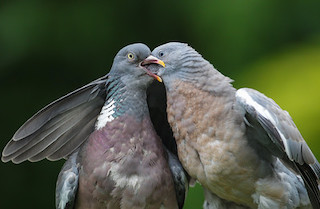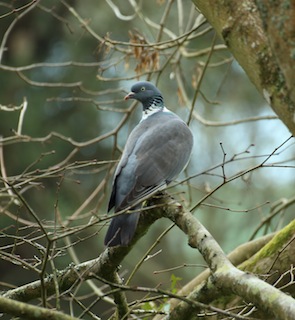 One of our more common bird species, the Woodpigeon is a familiar bird of woods, parks and gardens.
One of our more common bird species, the Woodpigeon is a familiar bird of woods, parks and gardens.
Photo: © Natural England/Allan Drewitt
Scientific name: Columba palumbus
Other common names: Common Woodpigeon, Ringed Dove, Culver (in south-east England)
Cornish name: Kudhon or Kolom Goos
Conservation status: IUCN Red List, Least Concern.
What to look for:
- Colouring and appearance: A large pigeon, mainly grey with a pinkish breast, with large white patch above purple patch on either side of neck, a white band on the wings and yellow eyes.
- Size: Wingspan of 68 to 77 cm.
- Where: Woods and fields; parks and gardens in urban areas.
- Call: Listen here
- Similar species: Stock Dove, which is smaller, and has faster wingbeats in flight.
 The Woodpigeon is the most common, and the largest, of pigeon species found in the UK. There are well over five million breeding pairs in the summer, and these numbers are swollen in the winter by birds migrating here from northern and eastern Europe, when they often form large flocks. Numbers are generally increasing, probably due to changes in agricultural practice, such as autumn sowing of cereal crops, that favour winter survival.
The Woodpigeon is the most common, and the largest, of pigeon species found in the UK. There are well over five million breeding pairs in the summer, and these numbers are swollen in the winter by birds migrating here from northern and eastern Europe, when they often form large flocks. Numbers are generally increasing, probably due to changes in agricultural practice, such as autumn sowing of cereal crops, that favour winter survival.
As its common name suggests this is a bird often found in woodland, but it is also found in trees in parks and gardens in urban areas, and can be an agricultural pest given its liking for root crops: it can legally be shot under a general licence from Natural England. This might explain its shyness in rural habitats, but in towns it is far less wary of humans.
 Adult birds are easy to distinguish from other UK pigeon species, because of their larger size and the two prominent white patches on the side of the neck (absent in juveniles until six months). The loud clattering of its wings as a Woodpigeon takes flight is a familiar sound of woodland walks, as is the sight of it perching in trees.
Adult birds are easy to distinguish from other UK pigeon species, because of their larger size and the two prominent white patches on the side of the neck (absent in juveniles until six months). The loud clattering of its wings as a Woodpigeon takes flight is a familiar sound of woodland walks, as is the sight of it perching in trees.
The white eggs are laid in clutches of two in a large untidy twig nest in a tree. Incubation takes a little over three weeks, and the young fledge in just over a month. The parents feed their chicks a nutritious milk produced in their crop. Adults’ main food items are seeds, fruit, crops and buds. They will visit bird tables.
Did you know…?
…In the most recent RSPB Big Garden Birdwatch, Woodpigeons were the fifth most common garden bird visitor.
…Woodpigeons are not always welcomed to bird tables by garden owners, as they outcompete smaller birds for food. BTO advice is to use birdfood which contains little or no cereal (Woodpigeons favour cereal crops).
More information and references:
Svensson, L., Mullarney, K., Zetterstrom, D.,1986. Collins Bird Guide, second edition (translated by Christie, D., Svensson, L.). HarperCollins, London.
Published: August 2014
Author: Amanda Scott
Photos: © Natural England/Allan Drewitt (top); Amanda Scott (bottom)
